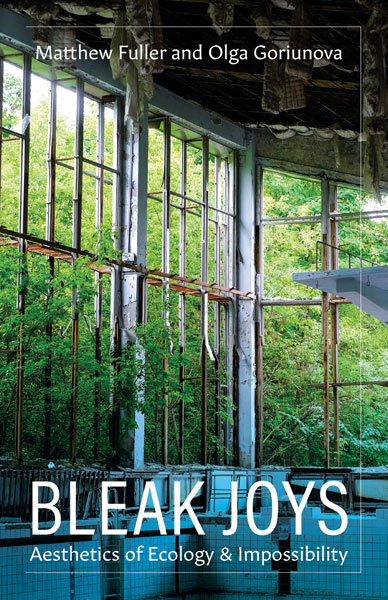Matthew Fuller, Olga Goriunova: Bleak Joys: Aesthetics of Ecology and Impossibility (2019)
Filed under book | Tags: · aesthetics, animal, chance, ecology, environment, ethics, forest, individuation, nature, philosophy, plants, subject, territory, theory, virtuality

“Bleak Joys develops an understanding of complex entities and processes—from plant roots to forests to ecological damage and its calculation—as aesthetic. It is also a book about “bad” things, such as anguish and devastation, which relate to the ecological and technical but are also constitutive of politics, the ethical, and the formation of subjects.
Avidly interdisciplinary, Bleak Joys draws on scientific work in plant sciences, computing, and cybernetics, as well as mathematics, literature, and art in ways that are not merely illustrative of but foundational to our understanding of ecological aesthetics and the condition in which the posthumanities are being forged. It places the sensory world of plants next to the generalized and nonlinear infrastructure of irresolvability—the economics of indifference up against the question of how to make a home on Planet Earth in a condition of damaged ecologies. Crosscutting chapters on devastation, anguish, irresolvability, luck, plant, and home create a vivid and multifaceted approach that is as remarkable for its humor as for its scholarly complexity.
Engaging with Deleuze, Guattari, and Bakhtin, among others, Bleak Joys captures the modes of crises that constitute our present ecological and political condition, and reckons with the means by which they are not simply aesthetically known but aesthetically manifest.”
Publisher University of Minnesota Press, Minneapolis, 2019
Posthumanities series, 53
ISBN 9781517905521, 1517905524
xxviii+192 pages
PDF (6 MB)
Comment (0)The Plantationocene Series: Plantation Worlds, Past and Present (2019)
Filed under book | Tags: · anthropocene, capitalism, environment, land, plantation, plantationocene, plants, politics

“The Plantationocene is an alternate name for the epoch often called the Anthropocene. Inspired by the scholars and artists visiting University of Wisconsin–Madison as part of the 2019-2020 Plantationocene Sawyer Seminar, this series aims to create a conversation about multiple forms of plantations, both past and present, their materialities, the economic, ecological, and political transformations they wrought, and their significance to the making of human bodies, capitalism, and land over the course of four centuries.”
Contributors: Sophie Sapp Moore, Monique Allewaert, Pablo F. Gómez and Gregg Mitman; Deborah A. Thomas; Raina Martens and Bii Robertson; Leanne Day and Rebecca Hogue; Kwynn Johnson; Donna Haraway and Anna Tsing, a.o.
Edge Effects dossier
Publisher Center for Culture, History, and Environment (CHE), Nelson Institute for Environmental Studies at the University of Wisconsin-Madison, 2019
Creative Commons BY-NC-ND 4.0 International License
The Iron Ring, an Art Project by Cecilia Jonsson (2014)
Filed under brochure | Tags: · art, environment, installation art, metallurgy, mineralogy, mining, plants
While “green mining” aims for a more ecological approach to mining metals, The Iron Ring explores how contaminated mining grounds may benefit from the mining of metals. For this work, 24kg of iron-tainted grass was removed from contaminated mining grounds and transformed into a ring of 2g metallic iron.
The project elaborates on the possibilities to utilize the cleansing process of the naturalized, wild growing grass: Imperata cylindrica. An invasive vile weed, which overlooked tolerance and ability to hyper accumulate iron inside its roots, stems and leaves are left unutilized. The Iron Ring proposes to harvest the grass for the purpose of extracting the ore that is inside them. The result is a scenario for iron mining that, instead of furthering destruction, could actually contribute to the environmental rehabilitation of abandoned metal mines.
The Iron Ring came about through trials and failures, in a process of close collaboration with smiths, scientists, technicians and farmers met along the way.
This e-book consists of two parts. The first is a visual essay by Cecilia Jonsson that reports on the seven chronological steps that were required to create an iron ring out of 24kg of grass harvested from the acidic river banks of a landscape in Spain severely transformed by opencast mining. In the second part, professor James Jackson Griffith, who participated in Jonsson’s preliminary research on mining restoration in Brazil, discusses The Iron Ring from an environmental-philosophical perspective.
Publisher V2_, Rotterdam, 2014
Open Access
PDF (4 MB, EPUB)
Comment (0)
